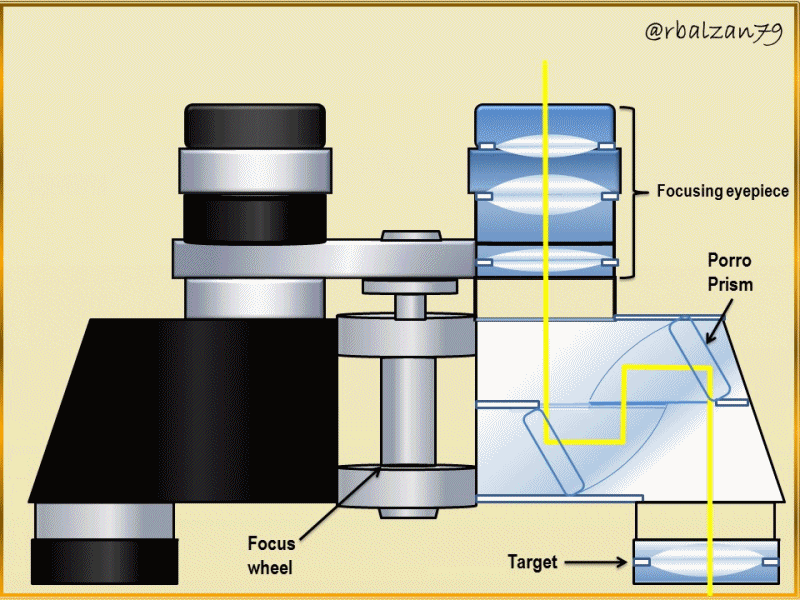
1.- Analysis and calculations of variables in the generation of images in a convergent lens.
2.- Calculations of variables in image generation in a diverging lens.
4.- Converging-converging lens arrangement in the optical system of a refracting telescope.
5.- Geometry implemented in the understanding of the algebraic formulation of thin lenses.
6.- Analysis of the arrangement of the optical system of a Newtonian reflecting telescope.
7.- Analysis of the arrangement of the optical system of a Newtonian reflecting telescope.
8.- Analysis of the optical elements of a Sextant.
We have seen so far the great usefulness of valuable optical instruments, such as, for example, the ancient overhead projector, refracting and reflecting telescope, the sextant, all taking advantage in the best way of the phenomenon of light for the projection of the different images observed towards our retinas, images from bodies or objects both near and far away. Within these valuable instruments, we have found optical elements such as flat mirrors, curved mirrors (concave and convex), lenses of convergent and divergent type, that is, the combination of these optical elements, now, apart from these elements, we will know a new element, the Porro prisms, for this, we can observe figure 1.
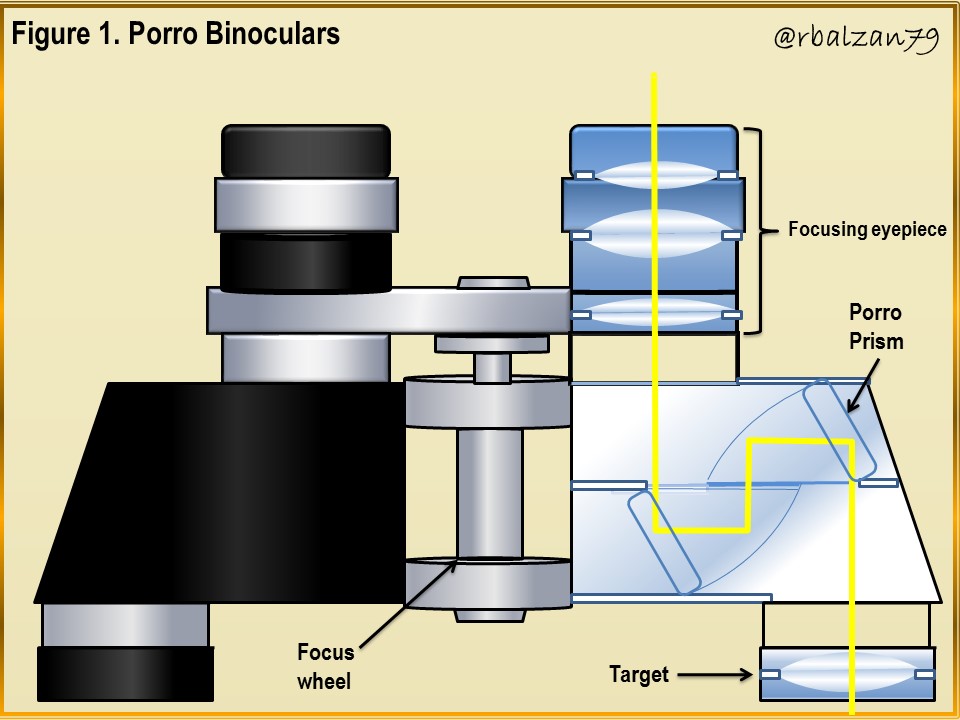
In the previous figure 1, we could observe the presence of all the component optical elements of the optical system of the Porro binocular, where, in addition to the Porro prisms, we find convergent lenses, which function as objective lenses and others as ocular lenses, therefore, let us begin to analyze the light ray diagrams in each of these lenses.
Therefore, in figure 1, we observe how the objective lens is of convergent type, then, in general, when we use this optical instrument is to observe objects or bodies that are beyond the focal length, that is, object focus (F), then, the image generated by this convergent lens in the objective, will be real and inverted (in relation to the orientation of the object or body observed) and, in addition, this image will be generated on the other side of the lens, therefore, let us observe the scheme of light rays in the following figure 2.
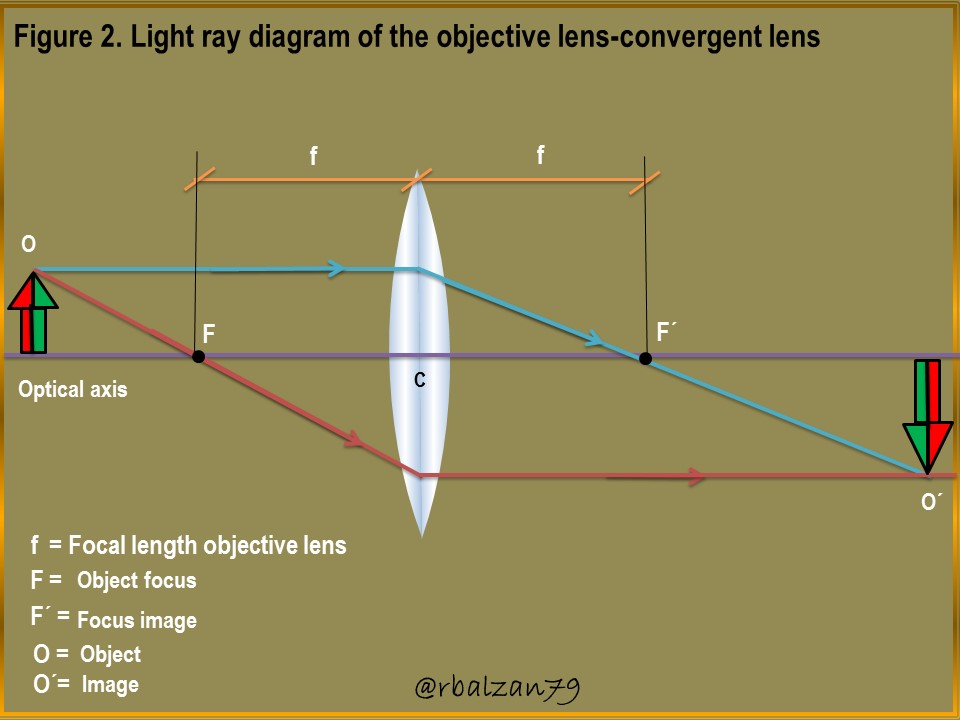
In the previous figure 2, we observe the scheme of two light rays that impact with the objective lens, a blue ray, which starts parallel to the optical axis and when refracted with the lens passes through the image focus (F'), then the second ray of red color, passes through the object focus (F) and when refracted continues parallel to the optical axis on the other side of the convergent lens, the image as we indicated is real and inverted and, in this way this image arrives to the following optical elements of this instrument, in this case the Porro prisms, let's see how the light rays behave in these prisms and, for this purpose, let's observe the following figure 3.
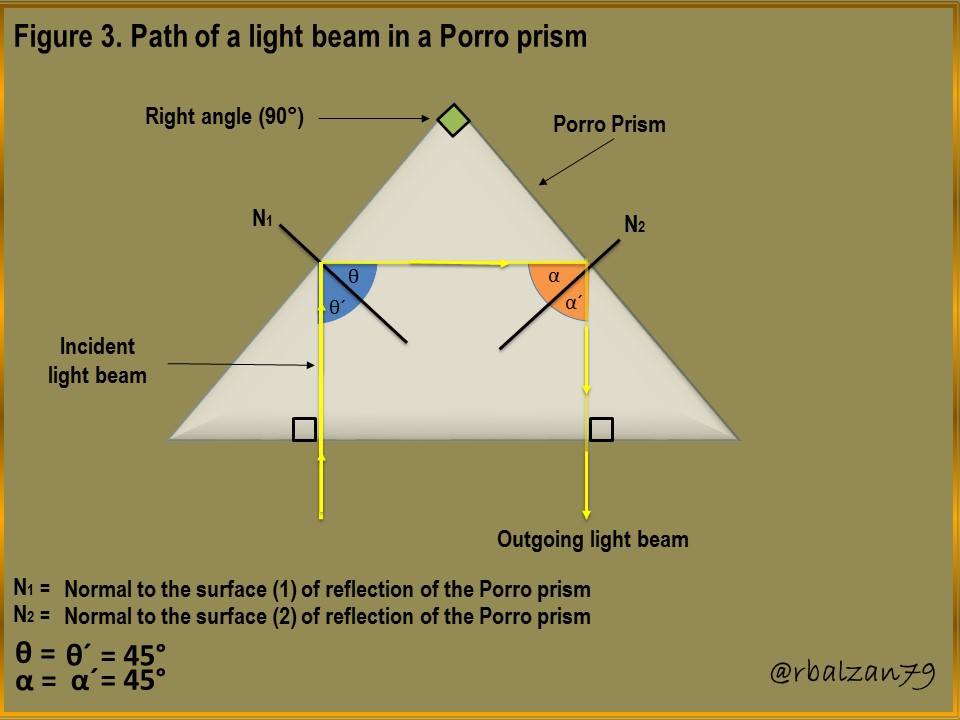
In the previous figure 3, we visualize how is the path of a light beam inside a Porro prism, this type of prism is also called reflective and, the same, represents a piece of glass with a rectangular isosceles triangular base (with a right angle of 90 °) as shown in Figure 3 above, we can see how, the light ray is incident perpendicularly on the base of the prism and, as it travels through the prism, it strikes one of the sides at an angle (θ) which in this case is 45° and is reflected at the same angle of 45° (θ'), carrying out the law of reflection, in the same way occurs on the other inner face of the prism where the incident light ray is reflected.
We observe in this way, then, that the light is not refracted, but, neither is it decomposed, taking place the phenomenon called, total internal reflection, but, what must happen so that this phenomenon of total internal reflection occurs or develops in this optical element (Porro Prism), for this, we must relate to an angle called critical angle (θc), this angle will tell us if the light rays are decomposed, refracted or totally reflected inside the prism, for this, let's know the following formula.

The above formulation represents the calculation of the critical angle (θc), for a combination of material or elastic media, in this case, it would be the air and the glass of which the Porro prism is made, if we focus on the path of light incident on one of the sides (the first), whose angle of incidence and reflection are 45 °, that is to say, θ = θ', respectively, then, at that point of incidence we would have that, the first medium would be the glass, whose index of refraction (n1) would be 1.5 approximately and, that of the air as second material or elastic medium involved would be 1, that is to say, n2=1, this would lead us to obtain the following critical angle:

In this way we obtain the critical angle (θc), that is, the permissible reference angle for the light to pass through a certain material (such as the Porro prism in this case), to be refracted, decomposed or totally reflected inside it, therefore, for a total internal reflection to occur, the angle at which the light strikes the boundary of the two material media must be greater than the critical angle, as occurs in our example, since the angles of incidence (θ and α) in the two faces are 45°, i.e., they are greater than the critical angle (θc) with 41.8°, this makes, then, that the light bounces or is reflected completely during the internal path of the Porro prism analyzed.
Now let's analyze how an image is generated in a Porro prism, remembering the orientation of the image offered by the objective lens, which is a convergent lens and its ray scheme left us an inverted image, this image will now be transferred by the first Porro prism, as you can see in the following figure 4.
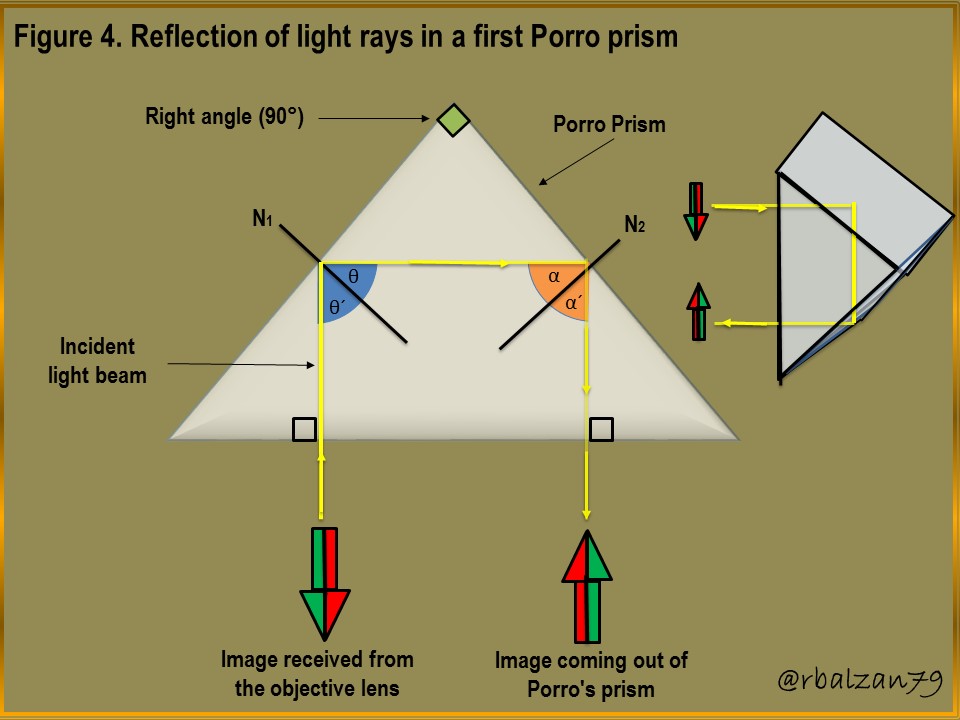
In the previous figure 4, we notice how the image coming out of the objective lens (convergent) arrived inverted to our first Porro prism, where, after a total internal reflection, the image is flipped when leaving the optical element, that is to say, it rotates 180° vertically and horizontally, in this way, now it will pass to our second prism, as you can see in the following figure 5.

In the previous figure 5, we notice how the second prism rotates the image 180°, but this time in a lateral way and, in this way, it reaches the component lenses of the ocular part of the optical instrument, now we will see how the image behaves in these lenses, which are convergent and have three (3) of these lenses, this will be analyzed in the following figure 6.
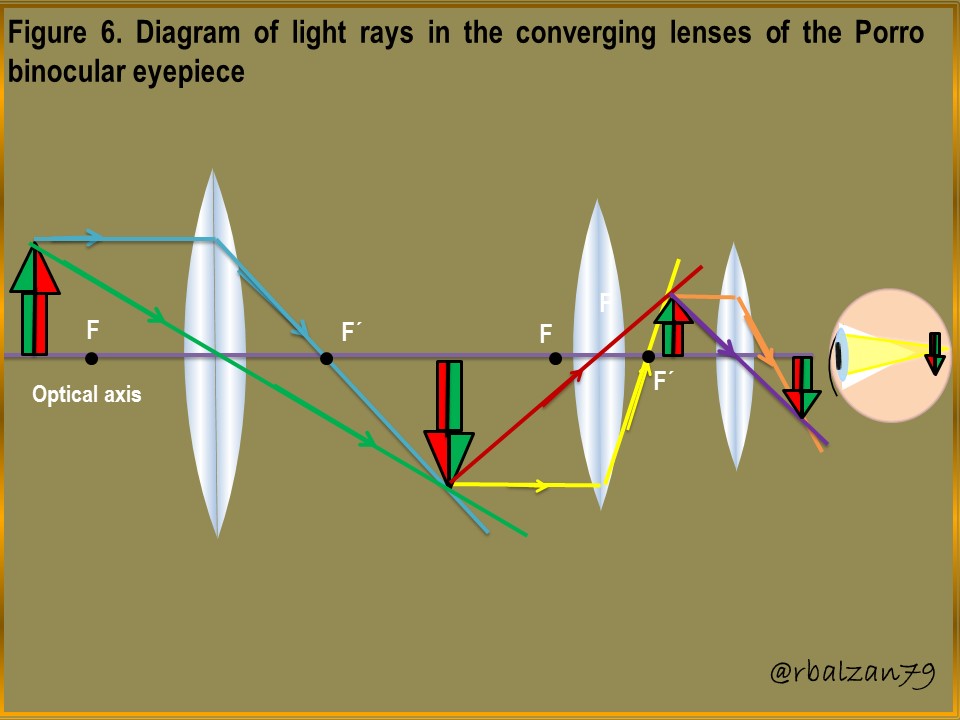
In the previous figure 6, the scheme of the luminous rays in the three (3) convergent lenses of the ocular space of this optical instrument (binocular) is observed, generating a final image which will be projected inverted on the retina of the person who observes through this type of Porro binocular.
Conclusion
We continue to see how each of the optical instruments designed, has a valuable utility for the knowledge of everything that surrounds us, including our outer space, of which we are constantly learning thanks to the invention of instruments such as these, which have essential and particular optical elements such as converging lenses and Porro prisms, for this case.
Many experts in optics indicate that the use of the double Porro prism offers a greater path of light and, thus, generating a greater focal length when leaving these optical elements, which would bring a reduction in the size of the optical instrument that implements them (in this case the Porro binoculars), we also analyze the well-known convergent lenses located in the ocular part of the optical instrument, which is closer to our eyes, it is constituted by convergent lenses (in this case three (3), with the purpose of projecting an inverted image in our retina, to name a characteristic of such lenses of the eyepiece.
Valuable characteristics offered by the Porro prisms, in this case, a total internal reflection, because the angles of incidence of the luminous rays on each of the prism walls were 45° (θ and α) and the critical angle (θc) when applying the formula 1, was 41.8°, above this value the light will be totally reflected inside these Porro prisms, later we will continue analyzing other optical instruments and their respective elements that constitute them.
Until another opportunity my dear friends.
Note: The images were created by the author using Power Point and Paint, the animated gif using PhotoScape.
Recommended bibliographic references
[1] GEOMETRIC OPTICS. Link.
[2] Convergent lenses. Link..
[3] Binocular Optics and Mechanics. Link.
Thanks for your contribution to the STEMsocial community. Feel free to join us on discord to get to know the rest of us!
Please consider delegating to the @stemsocial account (85% of the curation rewards are returned).
You may also include @stemsocial as a beneficiary of the rewards of this post to get a stronger support.
Thanks for the support dear @Stemsocial community. Regards.